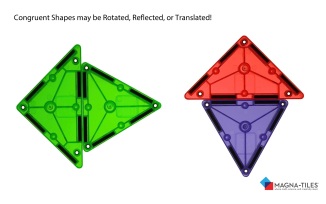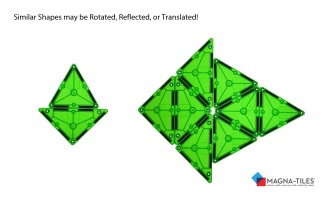A Semi-regular tessellation is made of two or more regular polygons. Q: What two Shapes do you see in the pattern below?

A: The Equilateral Triangle and Small Square!


A Semi-regular tessellation is made of two or more regular polygons. Q: What two Shapes do you see in the pattern below?

A: The Equilateral Triangle and Small Square!

A Tessellation is a tiling of shapes that fit perfectly together. There are no gaps or overlays! When the Tessellation is made by repeating one Shape (a regular polygon) in a pattern we call it a Regular Tessellation. When the tiling is made of two or more regular polygons, we call it a Semi-Regular Tessellation.
There are three regular polygons that can make Regular Tessellations: equilateral triangles, squares, and hexagons!
We can demonstrate the three Regular Tessellations with Magna-Tiles!
Equilateral Triangles

Small Squares

Hexagons

Cool Patterns! When two or more Shapes are used in a Tessellation, we call it a Semi-Regular Tessellation.
Magna-Tiles Connect: In Real Life, find Tessellations all around you in architecture, everyday objects, nature, math, and science!




Challenge Children to make a Magna-Tiles Mosaic!








This Hexagonal Pyramid was built outside on a snow day! See more Hexagonal Pyramids in Magna-Tiles Creations! Play and LEARN!

Magna-Tiles Math! Demonstrate geometry terms and concepts with Magna-Tiles for hands-on, visual learning.


Can we Describe two Shapes as Congruent even if they are positioned differently? Yes!

Are two Shapes Similar if one is flipped, turned, or moved over? Yes!


How can we make the same shape using ONLY triangles??

We can use right triangles instead of squares! Two right triangles (parts) cover one small square (whole)!
 One right triangle is half of a square. We need four right triangles! Play and LEARN!
One right triangle is half of a square. We need four right triangles! Play and LEARN!
Describe what changed from the first to second design.
Show me where there is a vertical line of symmetry.
To see new designs, visit the Geometry Daily Tumblr
Talk about shapes, symmetry, and patterns while viewing them with your students! Below are some of our favorites.
Magna-Tiles Math: Challenge your Children! What is the name of this equation?
This formula describes how, for any right-angled triangle, the square of the length of they hypotenuse (the longest side of a right triangle) equals the sum of the squares of the lengths of the other two sides.
Answer: The Pythagorean Theorem!
Why is the pythagorean theorem important?
LEARN more about the mathematician Pythagoras!
and about the Pythagorean Theorem from Khan Academy
Architect George L. Legendre collected and organized 92 different pasta shapes and studied their design! He says, “it’s really just trigonometry… everything is done with two functions”… ASK your kids about trigonometric functions SINE and COSINE – the invisible mathematics of pasta!
Different SHAPES of pasta give us a different experience and TASTE! Have you ever eaten fisarmoniche or strozzapreti?!
Where else do you see Magna-Tiles shapes and math in the real world? Use your noodle!
What shape does fazzoletti look like?!

What shape does ravioli look like?
Shapes are fun!

